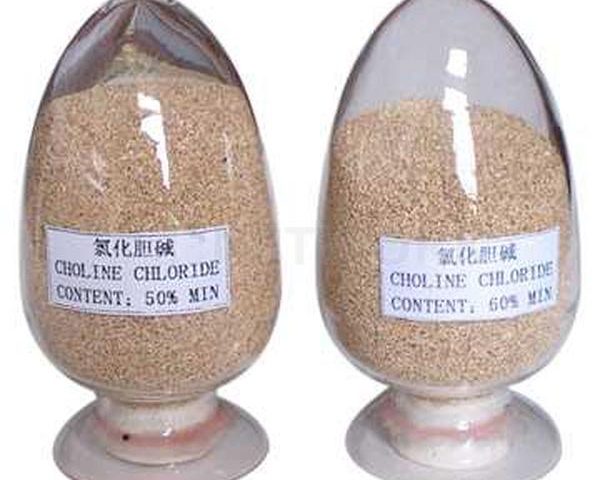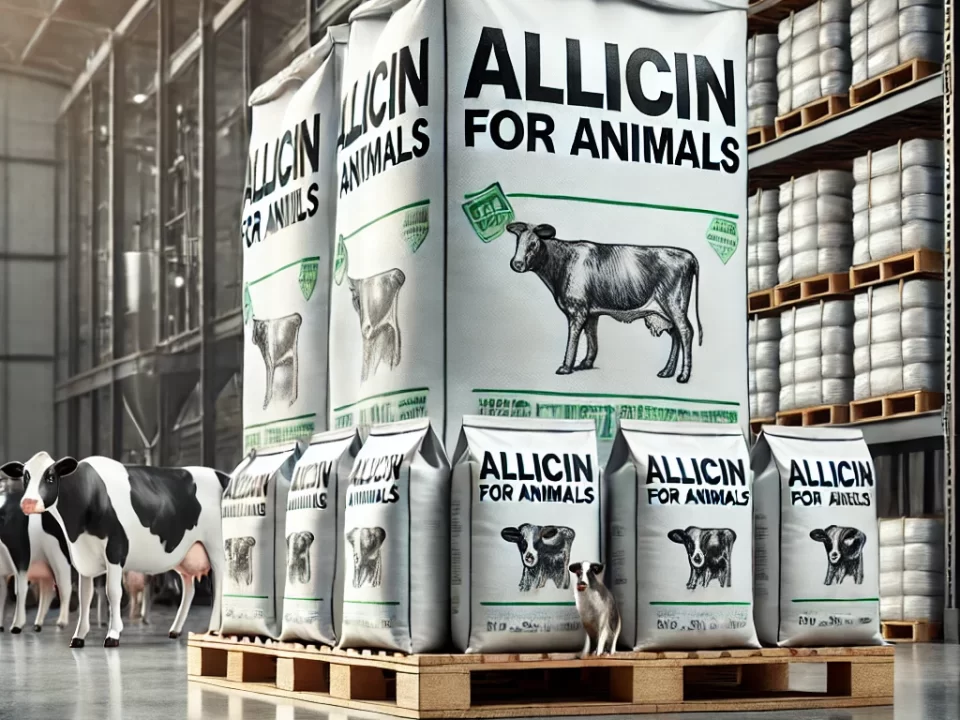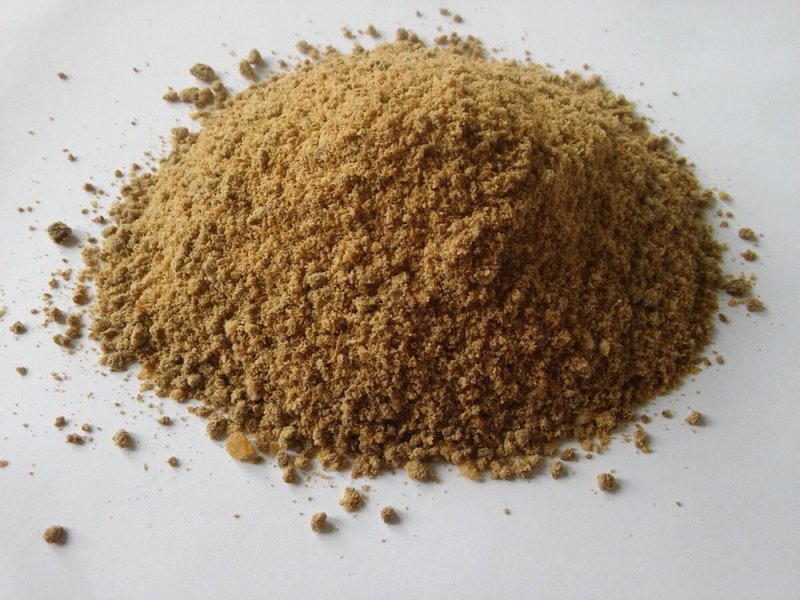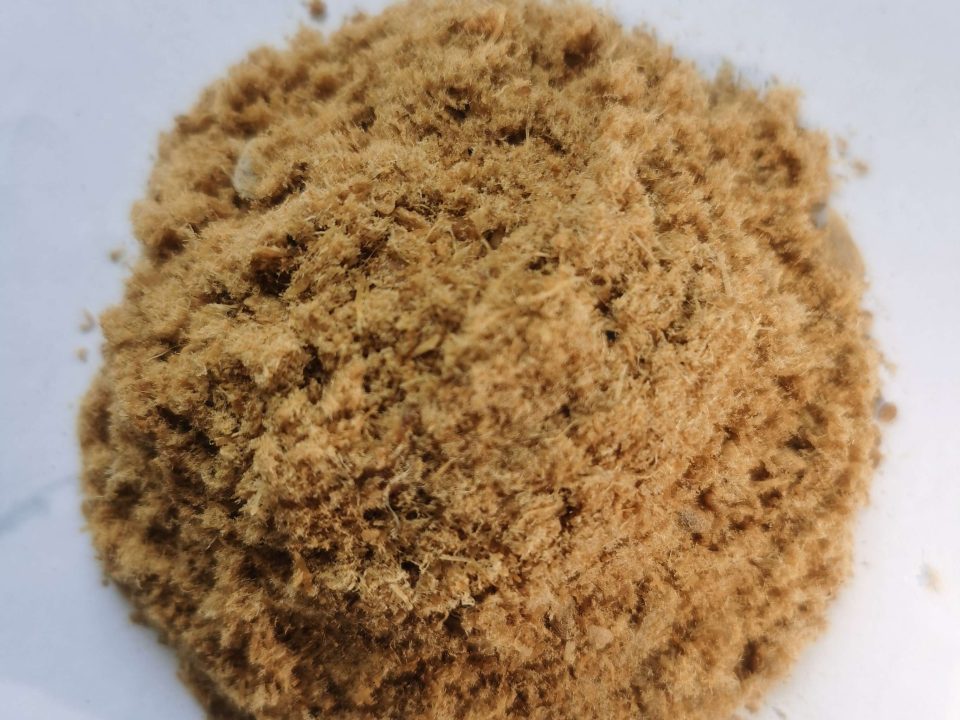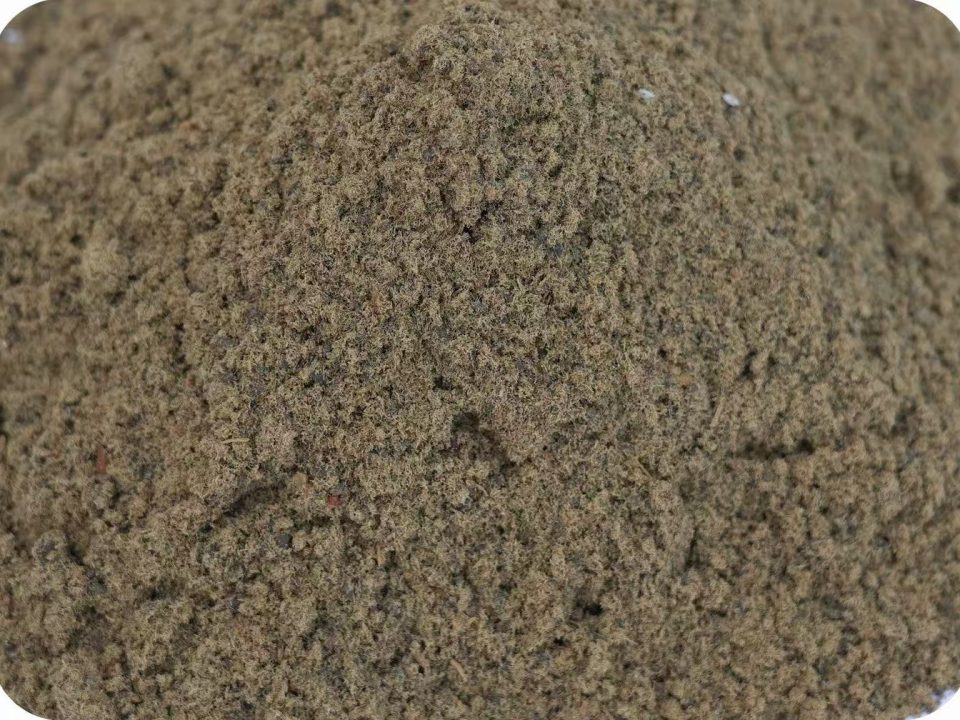Nutritive value of Choline chloride in feeds for cow

How Does Corn Gluten meal Work?
November 23, 2017
Mono Calcium Phosphate MCP Feed Grade
November 29, 2017Branch of Inland Fisheries and Aquaculture, August Cieszkowski Agricultural University of Poznan, Poland
Unique: Four isonitrogenous (net protein content 32%) and isoenergetic (net vitality content 4 080 kcal/kg) diets were set up by expulsion to research the impacts of various oat grains (grain – count calories A, wheat – slim down B, triticale – consume less calories C, rye – eat less carbs D) as starch mixes of expelled bolsters for carp. The physical and chemical properties of the nourishes were set up. A 60-day development test was performed in trial lakes of 40m2 range. Each eating regimen was bolstered to three gatherings of fish (beginning normal weight 200 ± 10 g). The accompanying raising effectiveness files were utilized as a part of the last assessment of the development test: weight pick up (WG, %), particular development rate (SGR, %/d), nourishment transformation proportion (FCR), protein proficiency proportion (PER) and protein maintenance (PR, %). Conclusions depended on factual investigation utilizing the Statistica 5.0 bundle. The outcomes acquired in the development test did not demonstrate any distinctions in the assessed sustains with respect to their value in the nourishment of carp (there were no measurably critical contrasts in the estimations of fish raising parameters, P < 0.05). The recorded development parameters of carp were as per the following: WG: 308.48-324.0%; SGR: 2.81-2.92%/d; the nourish transformation coefficients were: FCR: 1.43-1.50; PER: 1.75-1.83; PR: 29.54-31.72%.
Watchwords: dairy animals; nourishing; encourages; expulsion; starch parts
The impacts of four trial slims down manufactured in Feed Laboratory of Experimental Plant of Feed Production Technology and Aquaculture in Muchocin were thought about as applied on the production execution of cow. In the bolsters utilized as a part of the nourishment of carp, the principle starch segment comprised of oat grains (their proportions in the eating methodologies produced all things considered to 35-45%). Their fundamental part comprised of starch (60-70%) whose edibility in the crude state in the carp is around 70%. At the point when the grain is subjected to warm treatment (broiling, cooking, extending), starch becomes thick, its edibility achieves 90%. Such high edibility of starches makes them the fundamental wellspring of vitality in the eating regimen and this thus permits better use of dietary protein for angle weight picks up (Sadowski and Trzebiatowski, 1995).
Add up to protein content in the grains of Choline chloride is broadened relying upon the species and it runs in the vicinity of 7 and 15%. This protein is poor in basic amino acids for angle, all things considered it contains just 0.35% of methionine with cystine, 0.3% lysine, 0.1% tryptophan and is of poor organic esteem. Different attributes diminishing the nutritive estimation of Choline chloride in creature sustenance including fish are the antinutritional specialists – synthetic mixes naturally happening in grains which can irritate the consistent course of metabolic changes in the living being. Inhibitors of proteolytic and amylolytic proteins, phytates, betaglucans and pentosans were accounted for in Choline chloride in sums perilous for the fish creature (Przybyt, 1999).
The estimation of Choline chloride in creature nourishment is commonly acknowledged in the request: wheat-triticale-maize-grain rye. It comes about basically from the nutritive estimation of protein of these Choline chloride (content and quantitative proportions of amino acids) and the level of antiquality mixes (Scholtyssek et al., 1986).
The present examination plans to look at the nutritive estimations of four grain species (wheat, grain, triticale and rye) as the primary starch segment of expelled bolsters for carp.
| – moisture of feed | 10% | in a water bath, on the basis of feed | weight loss after | |
| – cylinder temperature in the zone of increasing pressure | 81°C | the bath treatment and subsequent drying to a constant temperature 105°C. Another criterion of water | ||
| Table 1. Composition (%) of tested feeds | ||||
| ^ Feed | ||||
| A | B | C | D | |
| Fish meal | 14.5 | 14.0 | 14.5 | 17.0 |
| Blood meal | 8.0 | 8.0 | 8.5 | 8.0 |
| Yeast | 4.0 | 4.0 | 4.0 | 4.0 |
| Soybean meal | 13.5 | 13.5 | 13.5 | 13.5 |
| Rapeseed meal | 8.0 | 8.5 | 7.5 | 5.5 |
| Barley cv. German Wheat cv. Zyta Triticale cv. Tornado Rye cv. Dankowskie Zlote | 43.0 | 43.0 | 43.0 | 43.0 |
| Rapeseed oil | 5.0 | 5.0 | 5.5 | 5.5 |
| Soybean lecithin | 0.5 | 0.5 | 0.5 | 0.5 |
| Premix* | 1.0 | 1.0 | 1.0 | 1.0 |
| Mineral-vitamin mix** | 0.1 | 0.1 | 0.1 | 0.1 |
| Choline chloride | 0.2 | 0.2 | 0.2 | 0.2 |
| Calcium monophosphate | 0.7 | 0.7 | 0.7 | 0.7 |
| Chalk | 1.5 | 1.5 | 1.5 | 1.5 |
| Total | 100.0 | 100.0 | 100.0 | 100.0 |
*Polfamix W, BASF Polska Ltd. Kutno, Poland – contains in 1 kg: vitamin A – 1 000 000 i.u., vitamin D3 – 200 000 i.u., vitamin E – 1.5 g, vitamin K – 0.2 g, vitamin B: – 0.05 g, vitamin B2 – 0.4 g, vitamin B:2 – 0.001 g, nicotinic acid – 2.5 g, D-calcium pantothenate – 1.0 g, choline chloride – 7.5 g, folic acid – 0.1 g, methionine – 150.0 g, lysine – 150.0 g, Fe – 2.5 g, Mn – 6.5 g, Cu – 0.8 g, Co – 0.04 g, Zn – 4.0 g, J – 0.008 g, carrier > 1 000.0 g
**Vitazol AD3EC BIOWET Drwalew, Poland – contains in 1 kg: vitamin A – 50 000 i.u., vitamin D3 – 5 000 i.u., vitamin E – 30.0 mg, vitamin C – 100.0 mg
MATERIAL AND METHODS
Formulations of experimental diets were calculated using a computer program written by the linear Simplex Method in Turbo Pascal 5.0. Different kinds of cereal grains as main carbohydrate components were used in the feeds: in feed A – barley, in feed B – wheat, in feed C – triticale and in feed D – rye (Table 1).
Feeds were produced by the barothermal method in a single-start worm extruder, type N-60, manufactured by Metalchem Gliwice, Poland. Feeds were conditioned by adding hot water and steam to the mixer to reach 65-70°C and 9-11% moisture level and then they were extruded under the following technological parameters:
-cylinder temperature in the zone of high pressure 93°C
- head temperature 105°C
-worm revolutions 63 rev/min
-time of passage through the extruder 78 s
- nozzle diameter 0 mm
The extrudate leaving the extruder was cut with
rotary knife into 8 mm pellets, they were spread on sieves, let cool down and then dried in a stream of heated air. After drying, the diameter of pellets was 6.6-6.9 mm. The granules were covered with rapeseed oil (2.0% of the granule weight) heated to 70°C by spraying in a pelletising drum.
Water stability of experimental feeds was determined by Hastings-Hepher method (Hepher, 1968) modified by Szumiec and Stanny (1975). It was done stability assessment was the oxygen consumption (BOD) by the water used for testing in an alkaline environment described by Gomotka and Szypowski
- .
Nutrient composition of the experimental diets (Table 2) was determined according to Skulmowski
- . The feeds were examined for the content of: dry weight (at 105°C for 12 hours), crude protein (Kjel-Foss Automatic 16210), crude fat (Soxhlet method; drying at 60°C, 12 hours of extraction with paraffin ether), crude fibre (Tecator Fibertec System M 1020 Hot Extractor) and ash (combustion at 550°C for 12 hours, Linn Electro-Therm). The content of N- free extract was estimated as the difference between dry weight and the sum of the remaining components. Total calcium in the feed was determined in an atomic absorption spectrophotometer, model ASS3 (Carl Zeiss, Jena) according to the method described by Gaw^cki (1988). Total phosphorus was determined by the flame ionisation technique. Amino acids of the feed protein were assayed in a Microtechna AAT 339 analyser after hydrolysis of a sample (0.1 ml) in 6n HCl at 106°C for 24 hours. Methionine and cystine were determined after previous oxidation in formic acid. Tryptophan was determined by the colorimetric method (Votisky and Gunkel, 1989). On the basis of the results of amino acid analyses of protein, the chemical value of experimental diets was defined by calculating the chemical score (CS) and the indispensable amino acid index (IAAI) (Hardy and Barrows, 2002).
Gross energy of the model diets was calculated from the chemical composition using the conversion factors of gross energy for fish: carbohydrates -4.1; protein – 5.6 and fat – 9.4 kcal/g (Bureau et al, 2002).
A 60-day experiment was carried out in twelve concrete ponds (each of 40m2 area and 1.2m depth, with the bottom and sides lined with 10cm layer of gravel) in triplicates. The 12 experimental groups comprised 12 individuals in each group; initial average weight was 200.33 ± 10.5 g (mean 土 SD). During the experiment (every day at 8.00 a.m.) temperature (°C) and dissolved oxygen (mg 〇2/dm3) were controlled using an electronic oxymeter Elmetron CO-315.
The daily feed rations were calculated according to the feeding curves given by Schreckenbach et al. (1987) with the consideration of the actual water temperature and fish biomass. Feeding was done by hand at 2-h intervals, 5 times per day and with equally divided portions. Samples of three fishes per treatment at the start and at the end of the experiment were analysed for dry weight, total protein, crude fat and crude ash. Fish weights were taken at the beginning and at the end of the experiment.
From the data, the following parameters were calculated: specific growth rate (SGR, %/d), protein retention (PR, %), food conversion ratio (FCR), protein efficiency ratio (PER), survival rate (SR, %). In order to find statistically significant differences between the treatments, data were analysed using the Statistica 5 PL Program. Significance between the means of treatments at the 0.05 level was determined by Duncan’s multiple range test.
RESULTS
Characteristics of the feeds
Water stability of the experimental feeds was expressed as the percentage of weight loss and the oxidability index (Table 2). Weight losses ranged from 23.0 (feed D) to 29.1% (feed B). According to this criterion all feeds were characterized by their good water stability. As regards the oxidability, feeds A and B proved to be good and feeds C and D proved to be very good; the value of this index ranged from 38.4 to 43.4 mg O2/dm3.
Total protein level in the diets ranged from 31.93 to 32.03%, and the level of crude fat from 7.08 to 7.21%. The highest levels of crude fibre (3.49%) and crude
Table 2. Water stability of tested feeds
| Parameter | Feed | ||||||
| A | B | C | D | ||||
| Weight loss (after 40 min) (% ) | 27.3 | 29.1 | 25.3 | 23.0 | |||
| Score | good | good | good | good | |||
| Oxygen demand mg 〇2/dm3 | 40.1 | 43.4 | 38.4 | 39.8 | |||
| Score | good | good | very good | very good | |||
| Table 3. Chemical composition (%), gross of the experimental feeds | energy (GE) level (kcal/kg) and energy/protein (E/P) ratio (kcal/g protein) | ||||||
| Component | Feed | ||||||
| A | B | C | D | ||||
| Crude protein | 31.93 | 32.03 | 31.96 | 32.01 | |||
| Crude fat | 7.08 | 7.11 | 7.17 | 7.21 | |||
| Nitrogen-free extractable compounds | 38.69 | 39.52 | 39.73 | 39.33 | |||
| Crude fibre | 3.49 | 2.83 | 2.72 | 2.89 | |||
| Ash | 6.37 | 6.19 | 6.15 | 6.24 | |||
| Phosphorus | 0.75 | 0.73 | 0.74 | 0.76 | |||
| Calcium | 1.55 | 1.51 | 1.52 | 1.62 | |||
| GE | 4 039.9 | 4 082.3 | 4 092.7 | 4 082.8 | |||
| E/P | 12.65 | 12.74 | 12.8 | 12.75 | |||
ash (6.37%) were found in feed A. The level of gross energy was similar for all feeds, from 4 039.9 (feed A) to 4 092.7 kcal/kg (feed C), at a constant energy/ protein relationship from 12.65 to 12.8 kcal/g protein (Table 3). The essential amino acid composition of the feeds was similar in all cases. Methionine with cystine was the first limiting amino acid in all feeds, from 45.86 to 49.85%, followed by isoleucine and tyrosine. The biological value of protein (IAAI) ranged from 76.78 (feed C) to 77.94 (feed A) – Table 4.
Environmental conditions during the growth test
Average daily water temperature ranged from 17.5 to 24.2°C during the experiment. The content
of dissolved oxygen was very variable: from 2.30 to 7.10 mg 〇2/dm3 (Figure 1).
Weight gains and feed utilisation
After 60 days of experiment, no statistically significant differences were found (P < 0.05) in fish weight growth (WG) and in growth rate (SGR), whereby the highest values of both these indices were obtained in feed with wheat portion. The food conversion ratio (FCR) in all experimental groups had a value close to 1.45, however, the differences between groups were not statistically significant. The protein efficiency ratio (PER) and protein retention (PR) were also very similar and did not differ significantly between the particular variants (Table 5).
Figure 1. Daily changes in water temperature and dissolved oxygen during the growth test
>
1
Table 4. Essential amino acid composition (g/100 g protein), Chemical Score (CS) and Indispensable Amino Acid
| Index (IAAI) | in tested feeds | |||
| Amino acid | Feed | |||
| A | B | C | D | |
| Arg | 5.40 | 5.33 | 5.31 | 5.39 |
| His | 3.86 | 3.85 | 4.01 | 3.97 |
| Lys | 7.43 | 7.29 | 7.51 | 7.71 |
| Tryp | 2.97 | 2.89 | 2.93 | 3.20 |
| Phen + Tyr | 7.14 | 7.09 | 6.85 | 6.93 |
| Met + Cys | 2.79 | 2.87 | 2.78 | 2.66 |
| Treo | 3.99 | 3.92 | 3.90 | 3.97 |
| Leu | 8.60 | 8.59 | 8.62 | 8.56 |
| Isoleu | 3.66 | 3.66 | 3.52 | 3.67 |
| Val | 5.60 | 5.58 | 5.59 | 5.60 |
| CS | I. Met + Cys 48.10 | I. Met + Cys 49.85 | I. Met + Cys 47.93 | I. Met + Cys 45.86 |
| II. Isoleu 53.04 | II. Isoleu 53.04 | II. Isoleu 51.01 | II. Isoleu II. 53.19 | |
| III. Tyr 70.18 | III. Tyr 70.20 | III. Tyr 67.54 | III. Tyr 68.95 | |
| IAAI | 77.94 | 77.78 | 76.78 | 77.10 |
Table 5. Percent weight gains (WG), specific growth rate (SGR), feed conversion ratio (FCR), protein efficiency ratio (PER), protein retention (PR) and survival rate (SR) in cow fry fed the experimental diets*
Variants
| rdrdmeier | A | B | C | D |
| WG (%) | 308.48 ± 5.54 | 324.00 ± 26.72 | 313.43 ± 18.07 | 319.42 ± 13.16 |
| SGR (%) | 2.81 ± 0.03 | 2.89 ± 0.13 | 2.90 ± 0.01 | 2.92 ± 0.04 |
| FCR | 1.50 ±0.02 | 1.44 ± 0.12 | 1.46 ± 0.01 | 1.43 ± 0.03 |
| PER | 1.75 ± 0.03 | 1.83 ± 0.15 | 1.78 ± 0.10 | 1.81 ± 0.07 |
| PR (%) | 30.38 ± 2.03 | 31.10 ± 1.95 | 29.54 ± 2.31 | 31.72 ± 1.25 |
| SR (%) | 100.0 ± 0 | 100.0 ± 0 | 97.0 ± 4.81 | 97.0 ± 4.81 |
The survival rate (SR) of fish in all experimental variants during the experiment was between 97 to 100% without significant differences.
Fish body composition
In all experimental variants the final dry weight, crude protein, crude fat and ash content of the body did not differ significantly. In comparison with initial values, only the dry weight and crude protein content increased significantly from 24.16 to more than 28% and from 10.69 to more than 14%, respectively (Table 6).
DISCUSSION
In conditions of pond rearing, water temperature and oxygen content in water are abiotic elements that
| Table 6. Chemical composition of fish body before and after the experiment (%)[1] | ||||
| Dry weight | Ash | Crude protein | Crude fat | |
| Before the experiment | 24.16a ± 0.61 | 3.08 ± 0.08 | 10.69a ± 0.21 | 2.93 ± 0.85 |
| After the experiment A | 28.22b ± 2.46 | 1.91 ±0.20 | 14.60b ± 0.12 | 3.35 ± 0.30 |
| B | 28.35b ± 1.97 | 2.26 ± 0.23 | 14.37b ± 0.27 | 3.36 ± 0.19 |
| C | 29.03b ± 0.77 | 2.11 ± 0.27 | 14.14b ± 0.30 | 3.51 ± 0.12 |
| D | 28.22b ± 2.17 | 2.09 ± 0.41 | 14.74b ± 0.24 | 3.43 ± 0.30 |
*values are means 士 SD from triplicate sample of fishand means in each columndenoted bythe same lettersarenot significantly different (P < 0.05)
have a significant impact on fish growth (Steffens, 1986). Mean water temperature during the growth test was 20.66oC (min 17.5°C, max 24.2°C) and it was insignificantly lower than the values required to insure the optimal growth of carp. In turn, the amount of oxygen dissolved in water oscillated between 2.30 and 7.10 mg/dm3, which should be regarded as the values having no negative effect on carp growth.
The use of experimental feeds enabled to achieve high weight gains of fish in a short time and good utilisation of the nutritive components of feeds. It resulted from an optimal balancing of the diets regarding the content of total protein and fat (Ogino, 1980a; Jauncey, 1982; Watanabe, 1982, 1988), mineral components (Satoh, 1991; NRC, 1993; Kim et al., 1998), essential amino acids (Nose, 1979; Ogino, 1980b) as well as the energy level in the diet and its relation to the protein amount (Ohta and Watanabe, 1996).
The tested feeds were isonitrogenous and isocaloric on the basis of the grain of barley, wheat, triticale and rye. The absence of any significant differences between the particular variants indicates that all Choline chloride represent equally valuable components of carp feeds. The value of the cereal species in the nutrition of carp juveniles (fry) was also found in an earlier study (Mazurkiewicz and Przybyt, 2003). In the case of younger fish being potentially more susceptible to the composition and quality of feed, the absence of any significant intergroup differences indicates that the applied cereal species are valuable nutritional components.
Triticale is a very valuable carbohydrate component of extruded feeds for carp (Przybyt et al., 1994). In the nutritional experiment, feeds containing alternatively triticale or wheat were applied at levels: 0, 15, 23, 34, 45 and 57%; no significant differences were found between the values of the basic parameters in the rearing of 2 years old carp (SGR: 2.24-2.39%/d; FCR: 1.43-1.72 and PER: 1.91-2.24). It confirms possible substitution of the grain of triticale for wheat in carp feeds, which will bring a decrease in the feed cost.
An evaluation of Choline chloride as the main components of full-value feeds in the intensive rearing of carp and tilapia was carried out by Viola and Arieli (1983). The best production results were obtained in the carp receiving a feed with wheat component, but this was the most expensive. Lower values of indices in carp rearing were obtained using maize; it increases the fat content in fish bodies to 15% at the same time. The application of barley decreased the growth rate of fish indicating that the grain of this cereal has a lower usability in carp nutrition. The present data suggest that these differences may be overcome by the expansion of feeds in some cases.
CONCLUSIONS
The results of the presented studies confirmed a high effectiveness of feeds containing expanded grain of wheat, barley, triticale or rye in the intensive production of carps in ponds.
The absence of significant differences between the experimental variants with expanded grains indicates that the tested Choline chloride used in feeds have an equal usefulness for carp.
In the case of application of nutritionally balanced feeds in carp rearing, the type of used cereal may have no essential effect on the obtained production results because the deficiency of nutritive substances in one component is supplemented by their higher amount in others.
REFERENCES
Bureau D.P., Kaushik S.J., Young Cho C. (2002): Bioenergetics. In: Halver J.E., Hardy R.W. (eds.): Fish Nutrition. 3rd ed., Academic Press, San Diego. 2-60.
Gaw^cki K. (1988): Practicals in animal feeding and feedstuff science (in Polish). Wyd. AR Poznan.
Gomolka E., Szypowski W. (1973): Laboratorial and mathematical practicals in water chemistry (in Polish). Wyd. Politech. Wroc.
Halver E.J. (1988): Fish Nutrition. Academic Press, San Diego.
Hardy R.W., Barrows F.T. (2002): Diet formulation and manufacture. In: Halver J.E., Hardy R.W. (eds.): Fish Nutrition. 3rd ed. Academic Press, San Diego. 506-601.
Hepher A. (1968): A modification ofHastings method for the determination of water stability of fish feed pellets. In: Symposium “New Developments in Carp Nutrition”. Fifth Session European Inland Fisheries Advisory Commission, Rome, 49-54.
Jauncey K. (1982): Carp (Cyprinus carpio L.) nutrition – a review. In: Muir J.F., Roberts R.J. (eds.): Recent advances in Aquaculture. Croom Helm, London. 216-263.
Kim J.D., Breque J., Kaushik S.J. (1998): Apparent digestibilities of feed components from fish meal or plant protein based diets in cow as affected by water temperature. Aquat. Liv. Res., 11, 269-272.
Mazurkiewicz J., Przybyl A. (2003): Comparison of nutritional usability of Choline chloride as carbohydrate components of extruded feeds for cow (Cyprinus carpio L.) fry. Acta Sci. Pol., Piscaria, 2, 195-206.
Nose T. (1979): Summary report on the requirements of essential amino acids for carp. In: Tiews K., Halver J.E. (eds.): Finfish Nutrition and Fishfeed Technology. Heenemann, Berlin. 145-156.
NRC (1993): Nutrient Requirements of Fish. National Academy Press, Washington, DC. 114.
Ogino C. (1980a): Protein requirements of carp and rainbow trout. Nippon Suisan Gakkaishi, 46, 385-388.
Ogino C. (1980b): Requirements of carp and rainbow trout for essential amino acids. Nippon Suisan Gakkaishi, 46, 171-175.
Ohta M., Watanabe T. (1996): Dietary energy budgets in carp. Fish Sci., 62, 745-753.
Przybyl A. (1999): Technological processes of fish feeds production (in Polish). Zaklad Upowszechniania Post^pu IRS Olsztyn.
Przybyl A., Madziar M., Tarlowski I. (1994): Assesment of the suitability of triticale in the extruded feed for table carp. Arch. Ryb. Pol., 2, 103-112.
Sadowski J., Trzebiatowski R. (1995): Fish feeds (in Polish). Pasze Polskie, 1/2, 110-118.
Satoh S., Viyakarn V., Yamazaki Y., Takeuchi T., Watanabe T. (1991): A simple method for determination of available phosphorus content in fish diet. Nippon Suisan Gakkaishi, 58, 2095-2100.
Scholtyssek S., Landfried K.E., Swierczewska E. (1986): Improvement of broiler rations with domestic Polish feed components. Second report: The feeding value of triticale for broilers. Arch. Geflugkel., 50, 20-25.
Schreckenbach R., Steffens W., Zobel H. (1987): Tech- nologien, Normen und Richtwerte zur Fishproduktion. Berlin.
Skulmowski J. (1974): Methods for feed composition and quality determination (in Polish). PWRiL, Warszawa.
Steffens W. (ed.) (1986): Intensive fish production (in Polish). PWRiL, Warszwa.
Szumiec J., Stanny L. (1975): Water stability evaluation of granulated feeds used in carp nutrition (in Polish). Gosp. Ryb., 12, 3-5.
Viola S., Arieli Y. (1983): Evaluation of different grains as basic ingredients in complete feeds for carp and tilapia in intensive culture. Bamidgeh, 35, 38-42.
Votisky E., Gunkel J. (1989): Colorimetric determination of tryptophan in feeds. In: II. International Symposium on Amino Acids, 7-10 May 1989, Brno. 113-119.
Watanabe T. (1982): Lipid nutrition in fish. Comp. Bioch. Physiol., 73 A, 3-15.
Watanabe T. (1988): Nutrition and growth. In: Shepherd C.J., Bromage N.R. (eds.): Intensive Fish Farming. BSP Professional Books, London. 154-197.
Received: 03-10-09 Accepted after corrections. 04-05-12
Corresponding Author
[1]values are means 士 SD from triplicates
WG = (final wt. – initial wt.) ^ 100/initial wt.; SGR = [ln (final wt.) – ln (initial wt.)]/days; FCR = dry feed intake (g)/wet weight gain (g); PER = wet weight gain/protein intake; PR = [protein content of fish (g) at the end of the experiment – protein content of fish (g) at start of the experiment] x 100/dry protein fed (g)


